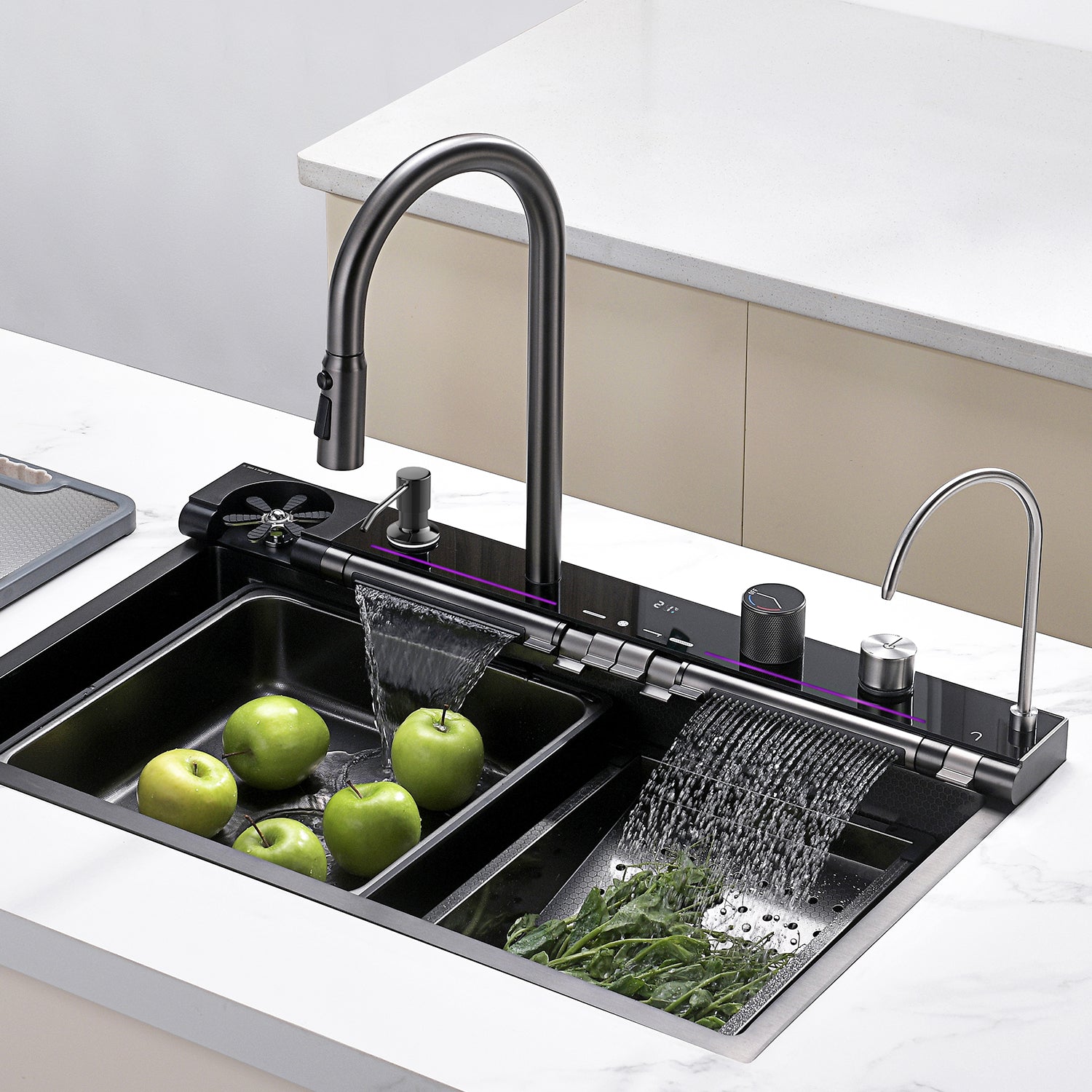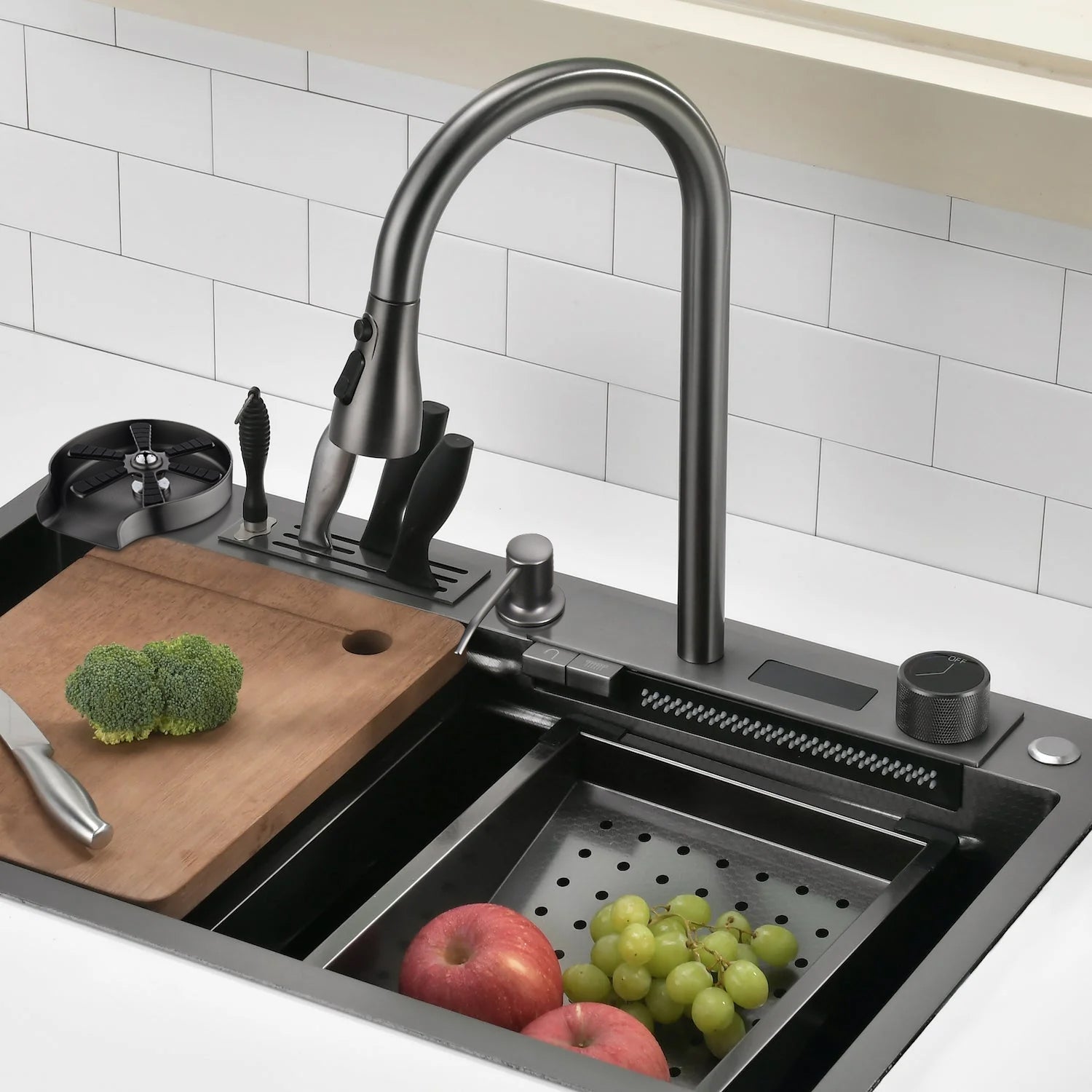How to Get Scratches Out of Stainless Steel Sink?
Do you think your scratched stainless steel surfaces are beyond repair? Think again! You don’t have to settle for unsightly scratches marring your stainless steel kitchen sink. We have innovative solutions and product recommendations to remove scratches from stainless steel items. This article will guide you in showcasing the best products for your Ruvati sink and stainless steel kitchen appliances.
Before we dive right in, it’s essential to understand how stainless steel reacts to various factors. Recognizing its susceptibility to scratches and why it’s so prone to them is necessary to tackle the issue correctly. Stainless steel, while praised for its durability and aesthetic appeal, is not impervious to damage. Its surface can quickly accumulate scratches, impacting its functionality and visual appeal. That said, let’s roll up our sleeves and get your stainless steel shining like new again.
Understanding Stainless Steel’s Vulnerability to Scratches
The vulnerability of stainless steel to scratches is primarily due to its intrinsic properties. Although this material is durable and resilient, it is susceptible to abrasion. Hard and sharp objects can easily mar it. Stainless steel’s low thermal conductivity and high expansion rate also make it prone to distortion during welding, contributing to an uneven surface that’s more susceptible to scratches.
However, the real challenge lies in preventing scratches and effectively removing them. Stainless steel scratches can be stubborn and tricky to erase, often requiring specialized techniques and products. Therefore, effectively removing scratches on stainless steel is crucial to maintaining its pristine condition. Innovation in this area is critical, and you’ll find various cutting-edge products and techniques designed to restore the surface to its original, unblemished state.
Understanding stainless steel’s vulnerability to scratches and knowing how to address it enhances the longevity of your appliances and preserves their aesthetic appeal, ensuring they remain a shining testament to your taste and style.

Types of Scratches on Stainless Steel
Identifying scratches on stainless steel is relatively easy. Locating light scratches on the surface might be challenging. You may need to use something other than running your fingers carefully to detect them. These are typically superficial from daily use and cleaning and are impossible to avoid. Your appliances are bound to get scratched, whether it’s due to magnets on the fridge or utensils in the sink. Using a flashlight to reflect against the change in texture is the best way to identify scratches that are not distinct.
To understand what to look for, we’ve created a list of the types of scratches that may occur to your kitchen sink.
- Superficial Scratches: These are superficial and often result from regular cleaning or light contact with other objects. They are usually easy to buff out.
- Scuff Marks:Caused by rubbing against other metal objects or abrasive materials. Scuff marks are usually superficial but can be slightly more challenging to remove. They can be buffed out quickly with the proper rubbing compound.
- Brushed Finish Scratches:Specific to stainless steel with a brushed finish. These scratches disrupt the uniform grain pattern and can be noticeable.
- Deep Scratches:Result from heavy impact or using sharp objects on the surface. These scratches penetrate deeper into the metal and are the most difficult to remove. These scratches may require elbow grease and sandpaper ranging from 400 to 4000 grit.
- Swirl Marks: Often occur from circular cleaning motions. They are a series of scratches that create a swirled pattern on the surface.
- Gouges:More severe than a scratch, gouges are deep cuts into the metal, often requiring professional repair or replacement of the affected area.
- Rainbow Heat Stain:High heat exposure can cause a rainbow stain on stainless steel discoloration. It can leave a scuffed or scratched appearance.
- Corrosion Marks: While technically not scratches, corrosion marks on stainless steel can appear as scratches or scuffs. They are often due to chemical exposure or moisture.
Techniques to Revive Your Stainless Steel
Deep scratches on stainless steel surfaces require more intensive techniques to effectively remove them. Here's a step-by-step guide on how to tackle those stubborn blemishes:
- Assess the Damage:Before diving into the removal process, assess the depth of the scratches. Determine if they are shallow enough to be buffed out or if they require more extensive treatment.
- Prepare the Surface:Clean the stainless steel surface thoroughly to remove any dirt or debris that could interfere with the repair process.
- Choose the Right Grit: Select sandpaper with the appropriate grit for the depth of the scratches. Start with a coarser grit, such as 400, and gradually move to finer grits, up to 4000, for a smoother finish.
- Sand the Scratches: Using light pressure, sand the scratches in the direction of the grain. Be consistent in your movements to maintain a uniform finish.
- Polish the Surface: Once the scratches are smoothed out, polish the surface using a stainless steel polishing compound. Apply the compound in circular motions, buffing the surface to a high shine.
- Final Touches: After polishing, clean the surface again to remove any residue from the polishing compound. Admire your handiwork as your stainless steel sink gleams like new!
Tailored Treatments for Different Stainless Steel Types
While it's essential to know how to remove scratches from stainless steel, prevention is always the best approach. Here are some tips to help prevent scratches on your stainless steel appliances:
- Use Soft Materials: When cleaning or wiping down stainless steel surfaces, use soft cloths or sponges to avoid scratching the metal.
- Avoid Abrasive Cleaners: Steer clear of abrasive cleaners or scouring pads, as they can scratch the surface of stainless steel.
- Protective Films: Consider applying a protective film or cover to high-traffic areas of your stainless steel appliances to prevent scratches and scuffs.
- Mind Your Utensils: Be cautious when using metal utensils or sharp objects near stainless steel surfaces to avoid accidental scratches.
- Regular Maintenance: Keep your stainless steel appliances clean and well-maintained to reduce the risk of scratches and maintain their appearance over time.
Elevated Fixes for Scratched Stainless Steel
Not all stainless steel is created equal, and different grades may require different care techniques. Here are some special considerations to keep in mind:
- Grain Direction: Pay attention to the grain direction of the stainless steel surface when cleaning or buffing out scratches. Always work in line with the grain to avoid causing further damage.
- Surface Finish: Brushed, satin, and polished finishes may require specific maintenance techniques to preserve their appearance. Refer to the manufacturer's guidelines for the best approach.
- Chemical Sensitivity: Some stainless steel alloys may be more sensitive to certain chemicals or cleaning agents. Always test any new products in an inconspicuous area before applying them to the entire surface.In addition to traditional methods, there are advanced solutions available for treating scratched stainless steel surfaces:
- Professional Repair Services:If DIY methods prove ineffective or if the scratches are particularly severe, consider enlisting the help of a professional stainless steel repair service.
- Refinishing Services: Some companies offer refinishing services for stainless steel appliances, which can help restore them to like-new condition.
- Replacement Parts: For deeply damaged stainless steel components, such as sinks or countertops, replacement parts may be available to restore the appearance of your kitchen or bathroom.
Frequently Asked Questions
Q: How Can I Determine the Grain of the Stainless Steel?
A: To determine the grain direction of stainless steel, examine the surface closely under bright light. The grain will appear as faint striations running parallel to each other. You can also try running your fingers lightly over the surface to feel the direction of the grain.
Q: How often should You Polish Stainless Steel?
A: The frequency of polishing stainless steel depends on factors such as usage and environmental conditions. As a general rule, it's a good idea to polish stainless steel surfaces every few weeks to maintain their shine and protect against scratches and corrosion.
Q: What is The Most Resistant Stainless Steel?
A: 316 stainless steel is often considered the most corrosion-resistant grade of stainless steel, making it ideal for use in harsh environments such as marine or chemical processing applications.
Q: Does Stainless Steel Rust if Scratched?
A: While stainless steel is highly resistant to corrosion, it can still rust if the protective chromium oxide layer is compromised. Scratches or deep gouges in the surface can expose the underlying metal to oxygen and moisture, leading to rust formation.
Q: Are Lefton Sinks scratch and rust resistant?
A: Yes, Lefton sinks are designed to be scratch and rust-resistant, thanks to their high-quality stainless steel construction and durable finishes. With proper care and maintenance, Lefton sinks will maintain their appearance and performance for years to come.






laissez un commentaire